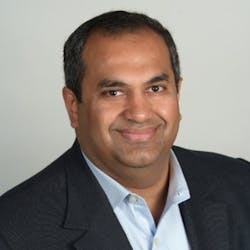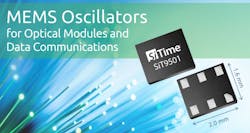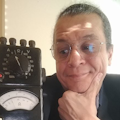Technology pressure occurs along every front, from materials to software, Advances from wide-bandgap semiconductors, to multiprocessor SoCs, to advanced AI machine-learning solutions, the embedded electronics industry is in the middle of a period of disruptive and evolutionary change. One thing that hasn’t changed, however, is the need for accurate timing and timekeeping.
In recent years microelectromechanical systems (MEMS), using silicon-etch manufacturing techniques to create complex microscopic 3D devices, has been creating MEMS-based oscillators to address timing applications. These devices continue to improve as the core technology behind them does.
Recently SiTime introduced the SiT9501 differential MEMS oscillator, based on the company’s latest third-generation MEMS technology, which delivers up to 7x better phase noise at half the power. The SiT9501 is presented as the industry’s lowest-jitter programmable oscillator, and includes the following features:
-Networking frequencies from 25 MHz to 644.53125 MHz
-70 femtoseconds of RMS phase jitter
-2.0 x 1.6 mm package, also available in other industry standard packages.
-Temperature range from -40° to +105°C
-On-chip voltage regulators to filter power-supply noise
-Innovative FlexSwing driver reduces power consumption by 30% and integrates source-bias LVPECL resistors
SiTime’s portfolio of differential oscillators offer jitter from 70 fs for high-speed communications to 1 ps for processing and computing applications. These oscillators can be configured to any frequency between 1 and 800 MHz, and are available in several industry-standard packages.
To get a better handle on the impact of MEMS-based timing in the electronics space, we met with Piyush Sevalia of SiTIme. We covered a range of timing, timekeeping, and related topics:
EE: Piyush, one of the things that I really would like to bring out is the whole aspect that time is literally everywhere, and it is something that we take for granted. Yet it is something that electronics literally cannot function without in the modern world.
Piyush Sevalia: Absolutely the case. Basically, we go around saying that timing is actually the heartbeat of electronics. And, just like a human heart, if it has problems, the human body is in trouble. It's the same thing with electronics. If the timing in the electronic devices is off for any reason, you've got a problem with that electronics functioning correctly. And it just manifests itself into all kinds of issues.
So you've got to have a really good heartbeat. Could be, you can look at it from the point of view of precision. You can look at it from the point of view of signal quality. You can look at it from the point of view of variations over time, but that it maintains time over long periods; six months, one year, five years, 10 years, 20 years. All these different aspects come into play in determining what we call the quality of the heartbeat.
EE: Well, one of the things that really comes to me strongly about timing, is timing in streaming and timing in communications is, from my old audiofile days, there was a lot of concern about jitter then, in the eighties, because well, music was the only streamed content that was "real time" because all other data, between checksums and just tell me three times, you could build up transmitted data, but any mistakes in the software, glitches, trips in jitter, you could hear it with music.
Piyush Sevalia: Absolutely. You can hear jitter in audio and you can hear all kinds of problems. When video came into prominence on CRTs, you could actually see jitter on the screen too, where your images would be wavy on the left corner or the right corner. And that was an indication that the clock was just not good, and it was causing problems when the scan and retrace was happening on the screen of the CRT.
EE: Right. Now, Piyush, when you think about it though, you've also got a lot of modern sources of time. Back in the day you had the cycle rate of the electric sine wave coming out of the socket in the wall. You had the Naval Observatory's radio signal, and then whatever electronics you had, like a TI-555 chip or something along those lines. But today, you could get timing from everything from GPS signals to, well, in your case, MEMS-based oscillators.
Piyush Sevalia: Absolutely. Yeah. I mean, there's a lot of sources of timing out there, and as we go along and as we get more connected, the world is just getting more connected. Usually connectivity used to be the purview of communication systems. But today, all your personal electronics are connected, not just to each other, but also to the internet.
It's moving into the industrial space, and machine-to-machine is becoming popular. Industry 4.0 is based on connectivity. And you're seeing the same thing happen pretty much in every field of electronics. Now, as all these electronics get more connected and then, slowly, not slowly actually, in many cases rapidly. As the data rates of transfer increase dramatically, you need to have all of these end-nodes be time-aware, that they are all synchronized with each other and the overhead of data transmission has minimized, whether it is in the form of channel efficiency, whether it is in the form of checksums, whether it's in the form of headers or not, the overhead has to be minimized.
That happens when everybody's time aware. Now, you can get a GPS signal fed into pretty much any electronics today, and the use of GPS is expanding. And that provides a very accurate source for time. But GPS also has some issues with indoor availability, which people are trying to solve, and also issues with availability in urban areas, where you have all these high buildings distorting the GPS signal.
So for electronics to be time-aware, and for electronics to continue to work reliably, we believe that there should be a localized timing source in the electronics that is very precise, that is very immune to all these disturbers when you're carrying your electronics around with you outside. And it's something that should be able to maintain accurate time for many years, for as long as you own the electronics, or for as long as the electronics are installed in the infrastructure. And that brings into prominence the real value of the heartbeat. It has to be accurate. It has to be good over long periods of time.
EE: Agreed, agreed. Now, let’s talk about your latest MEMS oscillator, OK?
Piyush Sevalia: We released a new type of differential MEMS oscillator, which addresses this whole concept of jitter. We've broken the hundred-femtosecond barrier on jitter, down to 70 femtoseconds, which is an amazing achievement. I mean, just on our previous generation devices, we've improved four times in the last couple of years or so.
Not only that, but we have an extremely good PSNR on the device, which allows us to offer the jitter in spite of there being noise on the power supply line, which as we know, impacts the timing performance of the device, the jitter performance of the device. And RPSNR, we've designed it to be appropriately good because we actually incorporated the regulation on-chip. So, you don't need an external regulator. You have an on-chip regulator that takes care of all of this, and basically makes sure that you get a good clean clock signal out.
This, we believe, is going to be powering the future of optical communications and data communications, because all of these are wireline transmission protocols, where jitter is massively important. And this new device allows them to get the best jitter that is out there, that's available from an oscillator.
This is a megahertz oscillator. Just a little bit of background on that. It's a megahertz oscillator. It's basically programmable, goes from one to about 800 megahertz, and you have the standard output protocols, LVDS, LVPECL, HCSL, all the differential signaling stuff that you need. Where's this useful? People are using 100 to 400G optical modules today, the next generation is going to be 400G to 800G. All in the quest of increasing bandwidth. And from that point of view, jitter has to be lower so that the performance of the system is better.
EE: Now, as you see the integration on silicon of all of these functions at the logic level, multi-core processors and SOCs, when do you start thinking we'll see integrated MEMS electronics packages?
Piyush Sevalia: Really good question. “Faster than you think” is my entire response to that one. The concept of integrating multiple clocks onto a single package has been around for awhile. And silicon companies, semiconductor companies have been doing it for awhile. I mean, I used to be part of Cypress a long time ago, and what we locally could provide at that time was the integration of the reference oscillator, or the reference resonator. The timing has to have a source, and in our case, the source is the reference resonator.
So, we basically put out two new devices, the differential oscillator earlier, for optical modules and data communications, and we also put out this integrated PLL-based MEMS-based PLL clock generator. And the beauty of this is, with the differential oscillator you're providing the reference.
With the clock generator, you're distributing this reference all over your board, so in a large complex networking system, you produce the differential oscillator as a reference, and then you can use the PLL clock generator to fan out clocks all over the board and drive all the different frequencies that are needed on the board. And we aren't the first, I believe, who have put this new PLL-based clock generator.
You can actually use it without even the differential oscillator if the situation so requires it. So with this, we have put together a complete clock system on a chip. I believe we are the first to do that, where we've integrated the MEMS resonator, we've integrated the oscillator and we've integrated the PLL and distribution circuitry all on one chip, so that we can solve system-level timing problems for our customers, and basically provide them a complete system on one chip.
EE: Well, because we're looking at this relentless convergence and integration, there are certain things that can't be miniaturized yet. Passives, magnetics, oscillators, resonators.
Piyush Sevalia: Yeah. But you know, we've done a pretty good job of miniaturizing timing devices. I think when we introduced our 32 kilohertz solutions a few years ago, we were 80% smaller than anything else that was out there.
EE: Right. But do you see a Moore's law kind of thing going with MEMS?
Piyush Sevalia: Well, it's kind of like compression algorithms, right? I mean, at some point you reach a limit, no questions about that. And, so when you reach a limit in terms of making it smaller, then you start integrating. And that's what we are doing with these clock generators that we are releasing. I mean, our MEMS die is already tiny, 0.4 by 0.4 millimeters, something like that. And so, and which is basically the smallest quartz device that I've seen out there is either a 1.0 by 0.8 or a 1.2 by 1.0 millimeter. So we are already less than a quarter of the size in terms of area.
When we couple on to that silicon expertise we have in integration and putting things together inside a package, we are providing full function solutions that we believe are very unique and that we believe that nobody else can provide. So size absolutely matters. Electronics are getting more dense, and we have a solution for that. Not only from just a raw size getting smaller, but also with our integration abilities, putting out a complete solution that occupies less space.
EE: Well, you know, and that's all really very interesting and cool for the engineer, but then that also presents an issue. It has to be dialed in differently than legacy solutions, right? It's a different test evaluation, certification process, right? Because you're not dealing with a thermally conditioned crystal oscillator anymore, you're dealing with a resonating piece of silicon.
Piyush Sevalia: So, we do that for our customers. So when we put out these solutions, whether it is an oscillator or whether it's a clock generator, we absolutely put it through the paces, so to speak, in terms of testing for temperature changes and performance in the presence of temperature changes, testing in the presence of, performance in the presence of voltage radiations, all kinds of stuff. We specify a lot of this in our data sheet.
We offer performance reports to our customers, which give detailed breakdowns of performance. In fact, there have been times when we've worked with some of the equipment providers, some of the major ones. Because, when we were testing our devices, we found some errors in the algorithms of their software. And we had to go feed it back to them and say, "Guys, for this interface, whether it's fiber channels and Ethernet, whatever it is, you guys need to modify your algorithm in this manner."
Because we could see that at the output of the device, and we could see the raw performance of the device. We saw the raw performance, we saw the filtered performance based on the filtering algorithms that these equipment use. And we said, "Look, there's a difference here. Something doesn't make sense." And we dug into it, and we found errors in the implementation of the software. So when we are providing these solutions to customers, we've put it through the paces. We've made sure that this device is going to continue to work. And that's why we have one of the highest reliability rates in the industry. I think they're about 30 to 50 times better in reliability compared to traditional quartz solutions.
EE: That's an impressive figure then, Piyush. Now, okay then, so, wow. I think we pretty much covered anything. Are there any final words you'd like to leave for our audience?
Piyush Sevalia: No, the only thing I'd say, and I'm sure your audience knows this really well. Timing is really, really important. It is the heartbeat of electronics, so pay attention to timing. Pay attention to all the data that your supplier provides. And, if you do that, I think your electronics is going to be in great shape.
About the Author
Alix Paultre
Editor-at-Large, Electronic Design
An Army veteran, Alix Paultre was a signals intelligence soldier on the East/West German border in the early ‘80s, and eventually wound up helping launch and run a publication on consumer electronics for the US military stationed in Europe. Alix first began in this industry in 1998 at Electronic Products magazine, and since then has worked for a variety of publications in the embedded electronic engineering space. Alix currently lives in Wiesbaden, Germany.
Also check out his YouTube watch-collecting channel, Talking Timepieces.


